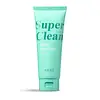What's inside
What's inside
 Key Ingredients
Key Ingredients

 Benefits
Benefits

 Concerns
Concerns

 Ingredients Side-by-side
Ingredients Side-by-side

Water
Skin ConditioningGlycerin
HumectantButylene Glycol
HumectantPEG-8
HumectantPEG-6 Caprylic/Capric Glycerides
EmulsifyingXylitol
HumectantAcrylamide/Sodium Acryloyldimethyltaurate Copolymer
Emulsion StabilisingPhenoxyethanol
PreservativeSaccharide Isomerate
HumectantIsohexadecane
EmollientBifida Ferment Lysate
Skin ConditioningAllantoin
Skin ConditioningChlorphenesin
AntimicrobialPolysorbate 80
EmulsifyingSorbitan Oleate
EmulsifyingSodium Hyaluronate
HumectantCitric Acid
BufferingSodium Citrate
BufferingWater, Glycerin, Butylene Glycol, PEG-8, PEG-6 Caprylic/Capric Glycerides, Xylitol, Acrylamide/Sodium Acryloyldimethyltaurate Copolymer, Phenoxyethanol, Saccharide Isomerate, Isohexadecane, Bifida Ferment Lysate, Allantoin, Chlorphenesin, Polysorbate 80, Sorbitan Oleate, Sodium Hyaluronate, Citric Acid, Sodium Citrate
Water
Skin ConditioningStearic Acid
CleansingGlycerin
HumectantMyristic Acid
CleansingPotassium Hydroxide
BufferingLauric Acid
CleansingCocamidopropyl Betaine
CleansingGlyceryl Stearate
Emollient1,2-Hexanediol
Skin ConditioningSorbitan Olivate
EmulsifyingPEG-100 Stearate
Sodium Chloride
MaskingChlorphenesin
AntimicrobialSodium Polyacrylate
AbsorbentArachidic Acid
CleansingPalmitic Acid
EmollientPolyquaternium-7
Ethylhexylglycerin
Skin ConditioningDisodium EDTA
Oleic Acid
EmollientMelaleuca Alternifolia Leaf Oil
AntioxidantLavandula Angustifolia Oil
MaskingMentha Piperita Oil
MaskingCapric Acid
CleansingSodium Benzoate
MaskingKaolin
AbrasiveCalendula Officinalis Extract
Skin ConditioningJasminum Officinale Extract
MaskingMelilotus Officinalis Extract
AstringentLavandula Angustifolia Extract
Skin ConditioningChamomilla Recutita Extract
Skin ConditioningRosmarinus Officinalis Extract
AntimicrobialCymbopogon Citratus Extract
Skin ConditioningThymus Vulgaris Extract
PerfumingRosa Canina Fruit Extract
AstringentHibiscus Sabdariffa Flower Extract
Skin ConditioningAspalathus Linearis Extract
Skin ConditioningLippia Citriodora Leaf Extract
AstringentMentha Piperita Extract
CleansingSodium Hyaluronate
HumectantHydrolyzed Hyaluronic Acid
HumectantSodium Acetylated Hyaluronate
HumectantSodium Bicarbonate
AbrasiveWater, Stearic Acid, Glycerin, Myristic Acid, Potassium Hydroxide, Lauric Acid, Cocamidopropyl Betaine, Glyceryl Stearate, 1,2-Hexanediol, Sorbitan Olivate, PEG-100 Stearate, Sodium Chloride, Chlorphenesin, Sodium Polyacrylate, Arachidic Acid, Palmitic Acid, Polyquaternium-7, Ethylhexylglycerin, Disodium EDTA, Oleic Acid, Melaleuca Alternifolia Leaf Oil, Lavandula Angustifolia Oil, Mentha Piperita Oil, Capric Acid, Sodium Benzoate, Kaolin, Calendula Officinalis Extract, Jasminum Officinale Extract, Melilotus Officinalis Extract, Lavandula Angustifolia Extract, Chamomilla Recutita Extract, Rosmarinus Officinalis Extract, Cymbopogon Citratus Extract, Thymus Vulgaris Extract, Rosa Canina Fruit Extract, Hibiscus Sabdariffa Flower Extract, Aspalathus Linearis Extract, Lippia Citriodora Leaf Extract, Mentha Piperita Extract, Sodium Hyaluronate, Hydrolyzed Hyaluronic Acid, Sodium Acetylated Hyaluronate, Sodium Bicarbonate
 Reviews
Reviews

Ingredients Explained
These ingredients are found in both products.
Ingredients higher up in an ingredient list are typically present in a larger amount.
Chlorphenesin is a synthetic preservative. It helps protect a product against bacteria in order to extend shelf life. In most cases, Chlorphenesin is paired with other preservatives such as phenoxyethanol and caprylyl glycol.
Chlorphenesin is a biocide. This means it is able to help fight the microorganisms on our skin. It is also able to fight odor-releasing bacteria.
Chlorphenesin is soluble in both water and glycerin.
Studies show Chlorphenesin is easily absorbed by our skin. You should speak with a skincare professional if you have concerns about using Chlorphenesin.
Learn more about ChlorphenesinGlycerin is already naturally found in your skin. It helps moisturize and protect your skin.
A study from 2016 found glycerin to be more effective as a humectant than AHAs and hyaluronic acid.
As a humectant, it helps the skin stay hydrated by pulling moisture to your skin. The low molecular weight of glycerin allows it to pull moisture into the deeper layers of your skin.
Hydrated skin improves your skin barrier; Your skin barrier helps protect against irritants and bacteria.
Glycerin has also been found to have antimicrobial and antiviral properties. Due to these properties, glycerin is often used in wound and burn treatments.
In cosmetics, glycerin is usually derived from plants such as soybean or palm. However, it can also be sourced from animals, such as tallow or animal fat.
This ingredient is organic, colorless, odorless, and non-toxic.
Glycerin is the name for this ingredient in American English. British English uses Glycerol/Glycerine.
Learn more about GlycerinSodium Hyaluronate is hyaluronic acid's salt form. It is commonly derived from the sodium salt of hyaluronic acid.
Like hyaluronic acid, it is great at holding water and acts as a humectant. This makes it a great skin hydrating ingredient.
Sodium Hyaluronate is naturally occurring in our bodies and is mostly found in eye fluid and joints.
These are some other common types of Hyaluronic Acid:
Learn more about Sodium HyaluronateWater. It's the most common cosmetic ingredient of all. You'll usually see it at the top of ingredient lists, meaning that it makes up the largest part of the product.
So why is it so popular? Water most often acts as a solvent - this means that it helps dissolve other ingredients into the formulation.
You'll also recognize water as that liquid we all need to stay alive. If you see this, drink a glass of water. Stay hydrated!
Learn more about Water